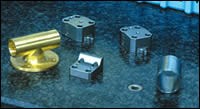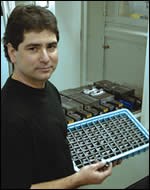New Vises Decrease Part Setup Time
During heavy milling operations, parts tended to creep upward and out of alignment within the vise jaws at this shop in Minnesota. Small chips got imbedded between the part and vise jaws, causing all kinds of problems. The company couldn’t operate its new Bridgeport VMC 1000 XP3 to its full potential on this part project, so the company's owner looked for a better workholding solution.
As a new company specializing in medical devices, including high-speed 3D machining and hard milling to 65 Rc, Vincent Precision Machining (Mendota Heights, Minnesota) has struggled through two different workholding setups that did not have the needed rigidity and holding power for its difficult to machine stainless steel medical parts.
“During heavy milling operations, parts tended to creep upward and out of alignment within the vise jaws,” explains Bill Ehnstrom, the company’s owner operator. “Small chips got imbedded between the part and vise jaws, causing all kinds of problems. We couldn’t operate our new Bridgeport VMC 1000 XP3 to its full potential on this part project, so we looked for a better workholding solution.”
The company was using a new Kitamura 2XiF machining center with two 3600 vises from Kurt Manufacturing Company (Minneapolis, Minnesota) at the time when these problems were occurring. Recognizing that workholding often holds the key to both high quality and a fair profit, Mr. Ehnstrom called in his local Kurt sales representative for his workholding recommendations on the shop’s new VMC.
The workholding challenge was a 1 1/2-inch × 1-inch × ¾-inch 420 stainless steel medical device component machined with a series of recessed flat and contoured surfaces inside a center slot. The goal was to produce these components to tight tolerances with an almost perfect finish to avoid secondary operations.
Quantity requirements for these parts averaged 250 a week, which was a stretch for the previously tested dual twin-station vise setup. Instead of two vises, the sales rep recommended five side-by-side mounted Kurt HDL vises on the VMC’s 1,200-mm × 600-mm (47.2-inch × 23.6-inch) worktable. For some machining centers, five ductile iron vises would prove to be too heavy. This machine, however, has a table load capacity of 900 kg (2,000 lbs) and easily accommodates the vises, which weigh less than 100 lbs each.
“The 420 stainless material is very hard and difficult to machine with the many complex features we required,” Mr. Ehnstrom reports. “The new vises with their ductile iron bodies gave us the rigidity needed. Plus, the machine table and base are all iron castings, so everything from the vise clamping stations down to the floor is solid iron. What can be more solid and rigid than that?”
Using changeable iron jaws machined to the medical components’ outer contours, the vises, in effect, become custom fixtures using a standard model vise base. The parts nest inside the machined jaws, so when the vise is clamped up, all outer surfaces are held tightly. When the part run is completed, jaws can be replaced with others for different jobs. The jaws themselves relocate quickly without special alignment tools.
“Part loading and unloading is really fast—less than a minute,” Mr. Ehnstrom says. “The parts position quickly within the jaw plate’s machined pockets. There’s no alignment needed. When the part is machined, less than a half-turn of the vise screw releases it. There’s no wasted motion or heavy labor needed with this setup. Before, with the aluminum-body vises, part loading took several minutes. Now with these HDL vises, it takes only seconds, plus the five vises handle 20 parts where before, the two vises handled only eight parts.”
These vises have an enclosed design, which makes it easier to blow out chips and coolant with an air hose, according to Mr. Ehnstrom. The five-vise setup also frees him for a full half hour to work on other projects while the machine cycles through all 20 clamping stations, he says.
Several features of the HDL vise design help expedite Vincent Precision Machining’s process for reduced cycle time while maintaining quality. With a 533.400-mm length (21 inches) and 152.400-mm width (6 inches), the vises are compact and position within 25.40 mm (1 inch) of each other so that less spindle travel is required, part to part, to get into and around parts for complex machining operations. With clamping force up to 5,556 lbs at 70 foot-pounds of input torque, these vises provide repeatable accuracy to 0.001 inch, well within the company’s tolerance requirements.
Mr. Ehnstrom also likes the quick-change jaw features of the vises. A half-turn of the vise hex key and the stationary jaw lifts off the vise body. The quick-change jaws self-align, allowing fast and accurate setup on the next job.
“The best machining center is only as good as the workholding used,” he concludes. “I tried three different vise setups and learned that when machining very hard materials, rigidity makes the difference. To get that rigidity, ductile iron is the only way to go.”
After upgrading to the HDL vises, Vincent Precision Machining found the rigidity needed to successfully machine its medical precision parts.
Related Content
Parting Off: The Case for Standardizing on Sawing
The value of rotary saw cutting for parting off operations could boil down to simple economics paired with process efficiency gains.
Read MoreBroaching Tool Technology For Lathes Used to Slot Inconel Parts
This shop finds value in using an indexable-insert-style broaching tool to create blind-hole slots in heat-treated Inconel aerospace parts on a CNC lathe.
Read MoreStarting Small with Automation
Quick-change workholding and flexible robotic automation started this small shop on the path to success.
Read MoreThe Value of Swiss-Types Milling Rectangular Medical Parts
High-speed spindle technology was key to effective milling of small cardiac monitoring components complete on a CNC sliding-headstock machine platform instead of running them across two mills.
Read MoreRead Next
Are You Medical OEM Material?
As the baby-boomer generation inexorably falls apart, screws, plates, rods and less invasive surgical tools are increasingly available to put "humpty" back together again. A question for many precision part makers is, "How do I get into the medical machining game?" To find out, we talked to a major OEM about its supplier selection criteria.
Read More5 Aspects of PMTS I Appreciate
The three-day edition of the 2025 Precision Machining Technology Show kicks off at the start of April. I’ll be there, and here are some reasons why.
Read MoreEmerging Leaders Nominations Now Open
Here’s your chance to highlight a young person in your manufacturing business who is on the path to be a future leader moving your company forward.
Read More














.png;maxWidth=300;quality=90)










